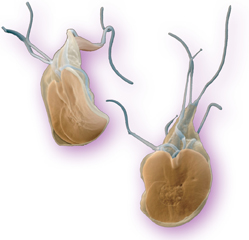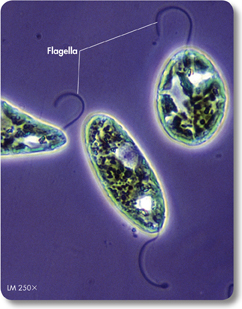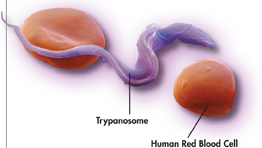Excavates 
KEY CHARACTERISTICS
Excavates (EKS kuh vayts) have a characteristic feeding groove, usually supported by microtubules. Most have flagella. A few lack mitochondria and are unable to carry out oxidative phosphorylation, although they do possess remnants of the organelle.
GROUPS OF EXCAVATES
The excavates include a wide diversity of protists, from free-living photosynthesizers to some of humankind's most notorious pathogens.

The diplomonad Giardia is a dangerous intestinal parasite that frequently contaminates freshwater streams. Giardia infections are common in wildlife and pet dogs and cats. (SEM 1800X)
DIPLOMONADS
These organisms get their name from the fact that they possess two distinct and different nuclei (from Greek, diplo = double). The double nuclei probably derived from an ancient symbiotic event in which one species was engulfed by another. Cells contain multiple flagella, usually arranged around the body of the cell. Most species of diplomonads are parasitic.

Photosynthetic Euglena gracilis is commonly found in lakes and ponds.
DISCICRISTATES
Discicristates (disk ee KRIS tayts) are named for the disc-shaped cristae present in their mitochondria. Some species are photosynthetic and free-living, such as Euglena, while others are dangerous parasites.

The ribbonlike cells of Trypanosoma brucei cause African sleeping sickness. The parasitic protist is transmitted by tsetse flies to humans, where it infects the blood, lymph, and spinal fluid. Severe nervous system damage and death are the usual result. (SEM 6700X)
Table of Contents
- Formulas and Equations
- Applying Formulas and Equations
- Mean, Median, and Mode
- Estimation
- Using Measurements in Calculations
- Effects of Measurement Errors
- Accuracy
- Precision
- Comparing Accuracy and Precision
- Significant Figures
- Calculating With Significant Figures
- Scientific Notation
- Calculating With Scientific Notation
- Dimensional Analysis
- Applying Dimensional Analysis




